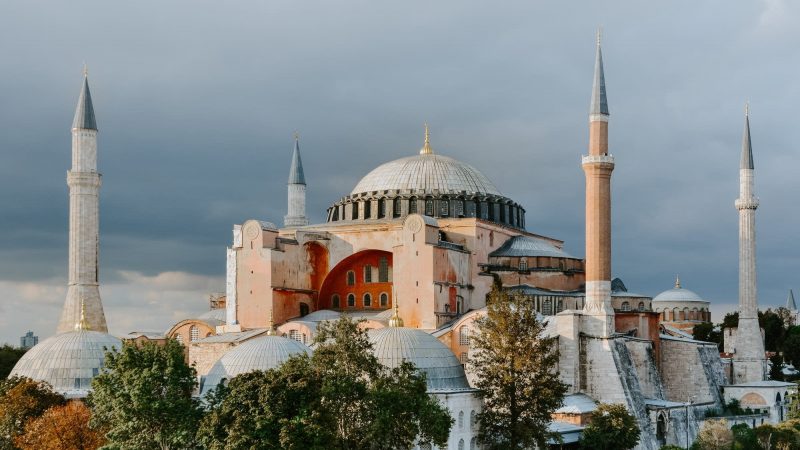Listen: The Sound of the Hagia Sophia, more than 500 years ago
Two scholars at Stanford have joined forces to recreate what a Christian choir might have sounded like inside Istanbul’s Hagia Sophia before it became a mosque in the 1400s.
Transcript
SCOTT SIMON, HOST: When the Hagia Sophia in Istanbul was built in the 6th century, it was the largest building in the world, an engineering marvel. And the unique acoustics inside inspired composers to write 10 centuries worth of religious music specifically to be sung there. Then the Ottoman Empire invaded in 1453, and the Hagia Sophia became a mosque. Choral music was banned, even the music of BJ Leiderman, who writes our theme music. And the sound of the Hagia Sophia was forgotten until now. Sam Harnett of The World According to Sound podcast has the story.
CAPPELLA ROMANA: (Singing in non-English language).
SAM HARNETT, BYLINE: This 13th century Byzantine chant is being sung by Cappella Romana, a choir from Portland, Ore. This is what they sound like in a studio.
ROMANA: (Singing in non-English language).
HARNETT: Now imagine – it’s the early 13th century. You’re sitting inside the Hagia Sophia. Marble pillars rise up around you. Dusty light filters into the windows in the massive dome above. And this is how you might hear Cappella Romana.
(SOUNDBITE OF ARCHIVED RECORDING)
ROMANA: (Singing in non-English language).
HARNETT: This transformation is possible because of two scholars at Stanford University in two very different fields. Bissera Pentcheva is a professor of art history.
BISSERA PENTCHEVA: A lot of my work is focused on reanimating medieval art and architecture.
HARNETT: Jonathan Abel is in the computer music department.
JONATHAN ABEL: I study the analysis, synthesis and processing of sound.
HARNETT: When they met, Pentcheva started telling Abel about the Hagia Sophia – how we couldn’t really understand the experience of worshipers there unless we could hear the music the way they did. And as she talked, Abel started to feel a prickling of excitement. They could recreate what that music would sound like. If only they could get in the Hagia Sophia and pop a balloon.
(SOUNDBITE OF BALLOON POPPING)
HARNETT: When a balloon pops, it makes an impulse, a sharp, quick sound that takes on the character of whatever space it’s in. So when a balloon pops, you’re really hearing the acoustics of the space itself, says Abel.
ABEL: The space interacts with the sound, bringing back to listeners information about the geometry, the size, the materials present, that sort of thing.
HARNETT: Pentcheva volunteered for the balloon-popping mission at the Hagia Sophia, which is now a museum. She flew to Istanbul and convinced the museum to let her in after hours.
PENTCHEVA: So I had all the equipment. And I spent five days in the space.
ABEL: The guard pops the balloon while Bissera’s wearing little clip-on microphones right near her ears. So the balloon pops. The sound echoes and reverberates through the space and is captured at Bissera’s head.
HARNETT: Remember that balloon pop?
(SOUNDBITE OF BALLOON POPPING)
HARNETT: Here is what Pentcheva recorded inside the Hagia Sophia.
(SOUNDBITE OF BALLOON POPPING)
HARNETT: Abel used the acoustic information in the balloon pops to create a digital filter that can make anything sound like it’s inside the Hagia Sophia.
ABEL: This process is called convolution. And it is a mechanism by which the acoustics of Hagia Sophia can be imprinted on any sound we desire.
HARNETT: And it’s only really been possible for the last 10 years or so because of advancements in our understanding of how sound works in a space.
(SOUNDBITE OF ARCHIVED RECORDING)
ROMANA: (Singing in non-English language).
HARNETT: So imagine – it’s the early 13th century. You’re sitting inside the Hagia Sophia. Marble pillars rise up around you. And dusty light filters into the windows in the massive dome above.
(SOUNDBITE OF ARCHIVED RECORDING)
ROMANA: (Singing in non-English language).
PENTCHEVA: It’s actually something that is beyond humanity that the sound is trying to communicate.
(SOUNDBITE OF ARCHIVED RECORDING)
ROMANA: (Vocalizing in non-English language).
HARNETT: Capella Romana recently released an entire album with this filter called “The Lost Voices of Hagia Sophia.” For NPR News, I’m Sam Harnett.
Copyright © 2020 NPR. All rights reserved. Visit our website terms of use and permissions pages at www.npr.org for further information.
NPR transcripts are created on a rush deadline by Verb8tm, Inc., an NPR contractor, and produced using a proprietary transcription process developed with NPR. This text may not be in its final form and may be updated or revised in the future. Accuracy and availability may vary. The authoritative record of NPR’s programming is the audio record.
